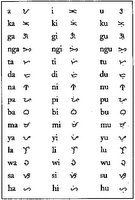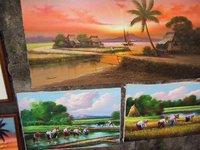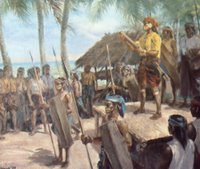 The Tagalog Script
The Tagalog ScriptIn 1571, the Spaniards found the people in Manila and other places writing on bamboo and specially prepared palm leaves using knives and styli. They were using the ancient Tagalog script which had 17 basic symbols, three of which were the vowels a, i, and u. Each basic consonantal symbol had the inherent a sound: ka, ga, nga, ta, da, na, pa, ba, ma, ya, la, wa, sa, and ha.
A diacritical mark called kudlit modified the sound of the symbol. The kudlit could be a dot, a short line, or even an arrowhead. When placed above the symbol, it changed the inherent sound of the symbol from a to i; placed below, the sound became u. Thus a ba with a kudlit placed above became a bi; if the kudlit was placed below, the symbol became a bu.
It was a simple and elegant system that was called baybayin. In 1914, the newer term alibata was introduced by Dean Paul Versoza of the University of Manila. He claims the term comes from alif, ba, and ta, the first three letters of the Maguindanao arrangement of the Arabic letters. He did not explain why he chose a totally unrelated writing system to name the script.
The Tagalog script was a syllabary, which means that each symbol represents a complete syllable. This is in contrast to our Latin alphabet where each symbol represents a phoneme, the smallest unit of the sound of speech. It is this distinction that makes it difficult for many people steeped in alphabetic systems to understand the correct way of using the Tagalog script.
The Tagalog script only represented two kinds of syllables, V and CV (C=consonant, V=vowel), whereas the language had V, CV, VC, and CVC types. Therefore only syllables like a, bi, or ku could be written down accurately. Syllables like ak, kam, pit, or ting (ng is one consonant) couldn't be represented in the system. Tagalog did not have consonant clusters like the CCVC, tram.
Missing final consonant
To write down syllables of the CVC type, the ancient Filipinos simply dropped the final consonant. Thus, ak would be written as a, kam as ka, pit as pi, ting as ti, and so on. The missing final consonant was somehow miraculously added back in when the text was read using a technique which we do not understand and which may forever remain a secret.
Those of us whose initial training in literacy was with alphabets may think only of context as what can give us clues about the unwritten final consonant. But there may have been other elements that we don't know about which helped the early people determine what the missing consonant was.
The Arabs who also use a syllabary (Gelb's classification) and only have three vowels, do not write down the vowels. They typically write down only the consonants. Their basic root word structure has three consonants and is written down as CCC. Each permutation can only represent one idea; ktb, for instance, has something to do with writing. Thus, kataba (he wrote), kutiba (it was written), and kutub (books) are all simply written as ktb. The specific permutation of the three consonants gives the meaning to the word making it easy for the reader to fill in the missing vowels from the context.
The above example illustrates how spoken and written components of a language interact in ways that may not be too obvious to non-users. That something similar could be the case with spoken and written Tagalog is very possible. Unfortunately, the script fell into disuse more than three centuries ago while the spoken component continued to evolve. This would make it very hard to do any analysis of this subject.
"Improvements" to the scriptThis deficiency of the Tagalog script as perceived by alphabet-using observers led to many proposals for "improvements" or extensions to the script. Although contemporaneous accounts indicate that users did not have too many problems in supplying the missing final consonants, the call for reforms started early and continues to this day.
In 1620, Fr. Francisco Lopez made the first logical proposal to improve the script. He proposed the use of a cross kudlit, so-called because it was a diacritic placed under the basic symbol and was shaped like a cross or "+". Its function was to cancel the inherent a sound associated with the basic script symbol. The cross kudlit turns the basic symbols into the phonemes k, g, ng, t, d, n, p, b, m, y, l, w, and s (but not h) suitable for use as final consonants and making it possible to write CVC syllables like kam, pit, and ting.
Fr. Lopez presented this innovation to the Tagalog writers of his time. Pedro Andrés de Castro, in his 1776 manuscript Ortografía y reglas de la Lengua tagalog, explains what happened:
The experts of the time were consulted, we read in the Tagalog orthography, about this new invention with the request that they adopt and use it in writing for the convenience of everybody. But after highly praising it and expressing their thanks, they decided that it cannot be introduced into their writing system because it was against the intrinsic nature and character given the Tagalog language by God and it would be equivalent to destroying in one stroke the whole syntax, prosody and orthography of their language. They expressed, however, that it was not their intention to slight the Spanish gentleman and that they would do what they were told especially when writing Spanish words in their Tagalog characters. In spite of the rejection of this innovation by users over 350 years ago, proposals continued to come up like stubborn weeds, even to this day. Besides the cross kudlit (or similar devices), extensions to accommodate five vowels (addition of e and o) and new consonants (f and r) have been proposed. Typical of these are recent works by Bayani Mendoza de Leon (Baybayin, the Ancient Script of the Philippines: A Concise Manual), Marius V. Diaz (Abakadang Rizaleo), and Kilusan ng Kalinangang Pilipino (various titles).
Besides misguided proposals of reform, there are many examples of outright misunderstanding of the Tagalog script typified by an article in the Philippine News Magazine (June 28-July 4, 1989) by Benito de Lumen.
Although orthographies published in the 16th and 17th centuries make it clear that the final consonant in a CVC syllable was dropped, de Lumen was unaware of it. Since the rules for the use of the Tagalog script are well-documented, inadequate research has to be the reason for its misunderstanding.
Better knowledge of the ancient script leads to a finer appreciation of its simplicity and elegance and an understanding of why the ancient users rejected reforms.
Source: Santos, Hector. "The Tagalog Script," US, October 26, 1996.

 The Tagalog Script
The Tagalog Script You know, there's actually a Filipino-American Heritage Month. It's October. Well, so I'm a little late, but in spirit of this past occasion, here's a set of Filipino-American facts anyways...
You know, there's actually a Filipino-American Heritage Month. It's October. Well, so I'm a little late, but in spirit of this past occasion, here's a set of Filipino-American facts anyways... The Philippines, also known as the pearl of the orient, is an archipelago located in southeast Asia. It consists of about 7,000 islands; a little more if it's low tide. It's quite hot all year round, and it seems that the heat only dissipates sometimes during the monsoon season or "wet season." During this time a series of typhoons slam the Philippines with strong rains. Apart from typhoons causing occasional floods, the Philippines also experiences volcanic eruptions every now and then; Mt. Pinatubo, Mt. Mayon, and Mt. Taal are some of the more active Philippine volcanoes in the past century.
The Philippines, also known as the pearl of the orient, is an archipelago located in southeast Asia. It consists of about 7,000 islands; a little more if it's low tide. It's quite hot all year round, and it seems that the heat only dissipates sometimes during the monsoon season or "wet season." During this time a series of typhoons slam the Philippines with strong rains. Apart from typhoons causing occasional floods, the Philippines also experiences volcanic eruptions every now and then; Mt. Pinatubo, Mt. Mayon, and Mt. Taal are some of the more active Philippine volcanoes in the past century. Most Filipinos are a combination of Malay, Chinese, Negrito (native Filipino), and Spanish blood, but may also have a mix of Japanese and American. The racial mix originated from eras of differing foreign rule. The Negritos or Aeta ( the natives of the Philippines) were the original inhabitants of the islands. Following these hunter-gatherers was a breed that included the mix of Malays from deep southeast Asia. The Malays basically crept up starting from Mindanao. The muslim culture stemming from Mindanao was thus born from the Malay migration. The next to step foot on Philippine soil would be the Chinese, or those originating from east Asia, as they migrated across the sea and intermixed with the natives and Malays of the Philippines.
Most Filipinos are a combination of Malay, Chinese, Negrito (native Filipino), and Spanish blood, but may also have a mix of Japanese and American. The racial mix originated from eras of differing foreign rule. The Negritos or Aeta ( the natives of the Philippines) were the original inhabitants of the islands. Following these hunter-gatherers was a breed that included the mix of Malays from deep southeast Asia. The Malays basically crept up starting from Mindanao. The muslim culture stemming from Mindanao was thus born from the Malay migration. The next to step foot on Philippine soil would be the Chinese, or those originating from east Asia, as they migrated across the sea and intermixed with the natives and Malays of the Philippines.